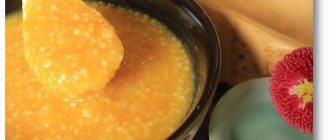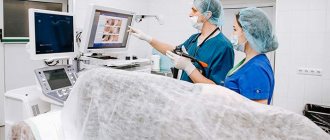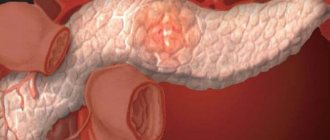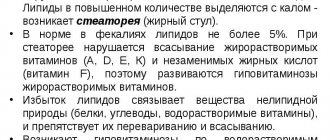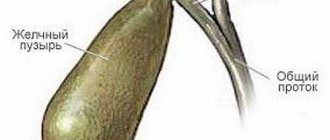Meckel's diverticulum - what is it?
Meckel's diverticulum is the result of incomplete fusion of the yolk sac
In the early period (from 7–8 weeks to 3–5 months) of intrauterine development, the embryo is nourished by the yolk sac (special embryonic tissue). In the first trimester, when the placenta has not yet formed, it is located in the navel area, connected to the small intestine of the fetus through a narrow canal - the vitelline duct. After the formation of a full-fledged umbilical cord and placental blood circulation, the reverse development of temporary embryonic structures occurs. The yolk sac with the duct collapses and resolves. If this does not happen, the part of the vitelline duct connected to the small intestine may take on the appearance of a protrusion on its surface - this is Meckel’s diverticulum.
Meckel's diverticulum is a congenital anomaly (feature) of the small intestine in the form of an additional pouch-like or tubular protrusion of the ileal wall. It looks like a process connected to the intestinal lumen. The anomaly received its name in honor of the scientist Johann Meckel, who first discovered and described it in 1809.
Typical characteristics of Meckel's diverticulum:
- location - antimesenteric (free from fatty deposits and blood vessels, facing the abdominal cavity) section of the ileum;
- length - from 1–2 cm to 16–20 cm;
- shape - bag-like with a wide base (more than 2 cm wide) or tubular with a narrow base (about 1-2 cm wide);
- appearance - a blindly ending process, similar to the intestinal wall in color and structure, may have a commissure connecting to the navel.
Video about the problem
Development of pathology
With true diverticula, all layers of the intestinal wall remain in place. And with false diverticula (pseudodiverticula), the mucous membrane constantly protrudes through the gaps in the muscular layer. True ones include congenital ones (we are talking about Meckel’s diverticulum), and false ones are acquired diverticula in the colon.
In the initial stages, the gallbladder duct, which is located next to the ileum, is formed by the seventh week of pregnancy. In cases where there is no atrophy of the area that connects it to the ileum, Meckel's diverticulum is formed.
Such cases are called congenital, and the diverticulum itself has all the properties of a normal intestine and extends in the area of the opposite attachment of the edge of the mesentery. In half of the cases it has heterotopic gastric tissue or pancreatic tissue. However, there are cases when he possesses two tissues at the same time.
Complications after diverticulum formation are rare, occurring in approximately 2% of patients. As for gender characteristics, in men this anomaly causes complications twice as often as in women.
Complications are: bleeding (they are also called diverticulitis), obstruction, as well as various other formations in the form of tumors.
Causes
There is no reliable data on the causes of the violation of the reverse development of the vitelline duct and the occurrence of Meckel's diverticulum. There are only assumptions about possible cause-and-effect relationships with certain factors. However, the causes of complicated forms of this anomaly are well studied.
Reasons for the development of pathology and its complications - table
| Why does diverticulum occur? | Why complications arise |
|
|
Complications of Meckel's diverticulum occur more often and are more severe in childhood. If they do not appear before the age of 30, the probability of their development does not exceed 5–10%.
Surgical removal of diverticulum
In some cases, doctors decide that it is necessary to remove Meckel's diverticulum. Surgery is necessary for complications such as intestinal obstruction, bleeding, and acute inflammatory process. In addition, surgery is recommended if umbilical cords are present. Potentially dangerous are diverticula with a narrow neck, as well as those structures that contain tissue from the mucous membrane of the stomach or pancreas: in such cases, the risk of sudden complications is extremely high.
Today, there are many surgical techniques; the choice here depends on the anatomical and physiological characteristics of the patient’s body. For example, the doctor may remove only the diverticulum. But in case of acute intestinal obstruction, resection of part of the intestine is also necessary. If there is a connection with the navel, the cord is also removed.
The prognosis for patients who have undergone surgery is quite favorable. Complications are usually associated with tissue infection. In approximately 4–6% of cases, intestinal obstruction develops after surgery, which requires additional therapy.
Classification
Both in childhood and in adults, Meckel's diverticulum can be of several types:
- Asymptomatic - does not cause any manifestations or symptoms throughout life (about 75–80% of cases). It is discovered as an incidental finding during diagnostic procedures (tomography, abdominal scintigraphy, laparoscopy), during operations for various diseases of the abdominal cavity.
- Complicated by acute conditions - diseases requiring emergency medical care (15–20%): diverticulitis, intestinal bleeding, intestinal obstruction, intussusception.
- Complicated by chronic diseases - health problems caused by diverticulum over a long period of time (weeks, months, years): anemia, tumor neoplasms (about 5%).
Types and symptoms of complications
Intestinal bleeding
Loose, dark cherry-colored stools called melena are a major sign of intestinal bleeding.
The most common manifestation of Meckel's diverticulum is bleeding into the intestinal lumen. Occurs due to the formation of ulcers (wounds) on the mucous membrane. Their cause is the cells of the stomach and pancreas, which are present on the mucous membrane of the diverticulum in 80%. They secrete aggressive enzymes that damage the vessels of the mucous membrane. The bleeding that occurs can be minor, chronic - the stool does not change color, or immediate heavy - the stool becomes bloody.
Symptoms of bleeding - table
| Complaints |
|
| Bloody stool (melena) | In case of acute heavy bleeding, stool resembles “raspberry jelly” - liquid, foul-smelling, cherry-colored. Minor bleeding does not change the color or consistency of stool. |
| Signs of blood loss | With severe bleeding: decreased blood pressure, rapid pulse (more than 90 beats/min), pale skin, impaired general condition. Chronic blood loss often causes anemia (decreased hemoglobin and red blood cells). |
Diverticulitis
Abdominal pain in the lower right region occurs with all complications of Meckel's diverticulum (most often with diverticulitis)
Inflammatory changes in Meckel's diverticulum are called diverticulitis. Inflammation either involves only the mucous membrane, or spreads to the entire thickness of the wall. In the first case, chronic diverticulitis occurs, in the second - acute. The latter poses an immediate threat to life and comes in the following types:
- Catarrhal. A simple inflammation that resolves with timely medical treatment.
- Phlegmonous. Purulent inflammation leading to destruction of the diverticulum.
- Gangrenous or gangrenous-perforated. Destruction (destruction) of the wall, leading to the spread of pus, harmful bacteria, and feces throughout the abdominal cavity. As a result, the most dangerous disease occurs - general peritonitis.
Symptoms of diverticulitis - table
| Complaints |
|
| Abdominal pain | At the beginning of the disease, when pressing on the abdomen, severe pain is detected in the navel area and below on the right side. When peritonitis occurs, severe pain and muscle tension throughout the abdomen is noted. |
| Signs of appendicitis | Acute diverticulitis and appendicitis have similar symptoms. Therefore, most cases of diverticulitis are discovered during appendectomy surgery. |
Intestinal obstruction
Abdominal bloating is characteristic of intestinal obstruction due to diverticulum
Meckel's diverticulum, which is long, wide, or has a cord-like adhesion to the abdominal wall, can cause mechanical compression of the intestine and obstruction. There are two options:
- intussusception - the introduction of a diverticulum with a wide base into the lumen of the small intestine;
- volvulus of the intestine around the diverticulum or the formation of a node between them.
Typical symptoms of intestinal obstruction:
- paroxysmal or constant pain throughout the abdomen;
- bloating, enlargement of the abdomen;
- fecal retention;
- violation of the passage of gases;
- nausea, vomiting;
- discharge of dark cherry-colored mucus with blood from the anus.
Intestinal bleeding and diverticulitis are the most common complications of Meckel's diverticulum in both adults and children.
Tumor formation
The presence of abnormal cells in the gastric mucosa, chronic inflammation, infections, and mechanical irritation of the gastric mucosa can cause the formation of malignant tumors in Meckel's diverticulum. This complication is rare (less than 5%). The tumor may manifest itself clinically as any of the other complications of a diverticulum: bleeding, inflammation, intussusception, intestinal obstruction, anemia.
Intestinal obstruction in this disease
Approximately 20-25% of complications occur due to intestinal obstruction. How can a diverticulum lead to this disorder? First, it can cause intussusception of the small intestine. Secondly, with such a pathology, the umbilical-mesenteric canal can be attached to the abdominal wall: in such cases, a loop of intestine can simply wrap around it. Occasionally, a tumor also forms in the wall of the diverticulum, which constantly grows and causes intussusception.
The main symptoms of intestinal obstruction are acute abdominal pain, frequent vomiting and constipation. In some cases, patients also experience jelly-like stools. A person with such complaints is referred for an X-ray of the intestine. After completing the diagnosis, the doctor decides on surgical intervention.
Unfortunately, the presence of Meckel's diverticulum is usually determined during surgery, since such a formation can not always be seen on x-rays.
Features of pathology in adults and children
Meckel's diverticulum is not a disease in itself. This is only an anatomical feature of the intestine, which in no more than 20–25% of cases can become the basis for the development of serious complications.
Features of Meckel's diverticulum in adults and children - table
| Peculiarities | Adults | Children | |
| Detection rate | About 2% of the population | 3–5% of the population | |
| Complication rate | About 10–15% of patients | More than 30–40% of patients | |
| Age of patients with complications | Before 30 years 80%, after 30 years 20% | 60–70% before 10 years, 30–40% after 10 years | |
| Predominant nature of complications | Inflammation, tumor development, obstruction | Bleeding, inflammation, intussusception | |
| Gender of patients | Uncomplicated forms of Meckel's diverticulum are recorded equally often in males and females, while complicated forms are recorded three times more often in men. | ||
| Mortality | From complications 1–2% | From complications 4–6% | |
| Additional yolk sac abnormalities | 70–80% are absent. In 10% there is a cord-like adhesion between the abdominal wall and the intestines. | Complete and incomplete umbilical fistulas, less often cord-like adhesion of the abdominal cavity. | |
Features of conservative treatment
Drug therapy is used only to relieve some of the symptoms of Meckel's diverticulum during acute inflammation.
More often, medications are prescribed to children, provided that the disease has appeared for the first time and is not complicated by life-threatening conditions.
Specialists, in the form of emergency assistance to the patient, prescribe:
- Antibacterial drugs to stop an infection that can cause an exacerbation of the disease.
- Anti-inflammatory medications help relieve pain and reduce inflammation symptoms.
- Infusion and detoxification agents are indicated for the development of peritonitis.
The recurrent nature of the disease and the absence of a positive trend with drug therapy is an indication for surgical treatment.
Diagnostics
An accurate diagnosis of Meckel's diverticulum can only be made during surgery by visually examining the intestine. Complications are diagnosed based on symptoms and clinical manifestations. Existing modern diagnostic methods are not 100% reliable.
Under the mask of any disease of the abdominal organs, complications of Meckel's diverticulum may be hidden.
Diagnostic methods used - table
| Methods for visual diagnosis of diverticulum | Scintigraphy | Intravenous administration of the radioisotope drug technetium (Tc 99). Using special X-ray equipment, the places where the isotope accumulates are monitored. They correspond to the location of Meckel's diverticulum (both complicated and uncomplicated). The reliability of the results is 50–60%. |
| Tomography | Computer or magnetic resonance imaging enhanced by intravenous administration of a reagent - layer-by-layer images of the abdomen in a three-dimensional image. The effectiveness of the method is more than 90%. | |
| Laparoscopy | Diagnostic surgery is the introduction of a special video camera into the abdominal cavity under anesthesia. Using manipulators, the intestines are examined. The method is 99.9% reliable. | |
| Ultrasound | It is possible to detect a diverticulum no more often than in 30%, mainly in children. | |
| Diagnosis of complications | X-ray of the abdomen | Determines signs of intestinal obstruction (swollen loops filled with fluid in the form of horizontal levels). |
| General blood analysis | An increase in leukocytes is characteristic of inflammation of the diverticulum, anemia (low hemoglobin, red blood cells) with complications of bleeding. | |
| Fecal occult blood test | If all the rules for taking the test are followed, and occult blood is detected in the stool, this may be due to chronic bleeding from the diverticulum. |
Modern approaches to treatment
The only way to get rid of Meckel's diverticulum is by removing it. To do this, either traditional surgery is performed through an abdominal incision, or laparoscopic intervention using punctures and a video camera. The second type of operation is preferable, but it is not always possible to remove the diverticulum in this way.
Not in all cases, the presence of Meckel's diverticulum is an absolute indication for its removal. It is better not to remove small (less than 2 cm) uncomplicated broad-based diverticula in children and adults under 30 years of age.
Surgical tactics and types of operations - table
| Clinical situation | Selection of optimal treatment tactics |
| Diverticulum diagnosed before surgery with chronic complications | A planned operation is indicated after a complete examination of the patient and correction of existing health abnormalities. The diverticulum is removed in the most appropriate way (cut-off, wedge-shaped or segmental resection of the small intestine along with the diverticulum), and the resulting wound of the small intestine is sutured. |
| Emergency surgery for diverticulum with acute complications | Mandatory removal in one of the following ways:
|
| Incidentally discovered uncomplicated diverticulum | Removal is advisable in the following cases:
|
Treatment of Meckel's diverticulum - photo gallery
Antibiotics, antispasmodics, hemostatics and other drugs do not relieve diverticulum
The second stage of the operation is suturing the wound of the small intestine after excision of the diverticulum
The first stage of the operation is excision of the diverticulum.
Drug treatment
Medications complement the complex treatment of complications of Meckel's diverticulum. Are used:
- Antibiotics: Cefotaxime, Ceftriaxone, Levofloxacin, Ornidazole. Indicated for diverticulitis.
- Antispasmodics: Renalgan, Spazmalgon, No-shpa, Platifilin. Reduce pain and inflammation.
- Hemostatics (hemostatic agents): Dicinone, Etamsylate, Tranexamic acid, Vikasol. Indicated for acute intestinal bleeding.
- Infusion solutions: Ringer, Glucose 5%, Reosorbilact, Xylate. Restore water balance, reduce intoxication, and replenish blood volume deficiency.
- Antisecretory agents: Kvamatel, Omeprazole, Pantoprazole, Nexium. Reduces the secretion of gastric and intestinal juices.
Diet features
General principles of dietary nutrition:
- frequent - 5–6 times a day;
- fractional - small single portions;
- correct characteristics of food - warm or cool, mushy;
- no irritating effect - exclude spices, hot foods, marinades, seasonings;
- cooking method - boil, stew, bake, steam. Avoid fried and smoked foods.
Foods for Meckel's diverticulum - table
| Products | Can | It is forbidden |
| Meat | Rabbit, chicken, young beef, turkey, lean fish | Goose, duck, pork, fatty beef and fish |
| Dairy | Low-fat kefir, fermented baked milk, yogurt, cottage cheese | Whole milk, high-fat fermented milk products |
| Bakery | Day-old bread, bran, crackers, dry biscuits | Fresh bread, baked goods, cakes, pastries |
| Vegetables and fruits | Cabbage, banana, plums, beets, carrots, small quantities of tomatoes, grapes, apples | Radish, radish, garlic, hot pepper |
| Cereals, porridge | Rice, oatmeal, buckwheat, barley | Legumes, peas, wheat pearl barley |
| Beverages | Compote, weak black and green tea, uzvar, jelly | Coffee, alcoholic drinks, strong tea, any soda |
Prohibited products in the photo
Radish
Whole milk
Legumes
Baking
Alcoholic drinks
Coffee

